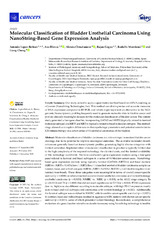Mostrar el registro sencillo del ítem
Molecular Classification of Bladder Urothelial Carcinoma Using NanoString-Based Gene Expression Analysis
| dc.contributor.author | López-Beltrán, Antonio | |
| dc.contributor.author | Blanca, Ana | |
| dc.contributor.author | Cimadamore, Alessia | |
| dc.contributor.author | Gogna, Rajan | |
| dc.contributor.author | Montironi, Rodolfo | |
| dc.contributor.author | Cheng, Liang | |
| dc.date.accessioned | 2021-11-02T10:14:04Z | |
| dc.date.available | 2021-11-02T10:14:04Z | |
| dc.date.issued | 2021 | |
| dc.identifier.uri | http://hdl.handle.net/10396/22008 | |
| dc.description.abstract | Molecular classification of bladder carcinoma is a relevant topic in modern bladder cancer oncology due to its potential to improve oncological outcomes. The available molecular classifications are generally based on transcriptomic profiles, generating highly diverse categories with limited correlation. Implementation of molecular classification in practice is typically limited due to the high complexity of the required technology, the elevated costs, and the limited availability of this technology worldwide. We have conducted a gene expression analysis using a four-gene panel related to luminal and basal subtypes in a series of 91 bladder cancer cases. NanoString-based gene expression analysis using typically luminal (GATA3+/KRT20+) and basal markers (KRT14+/KRT5+/GATA3low/-/KRT20low/-) classified urothelial bladder carcinoma samples as luminal, basal, and a third category (KRT14-/KRT5-/GATA3-/KRT20-), null/double negative (non-luminal/non-basal). These three categories were meaningful in terms of overall cancer-specific survival (p < 0.0001) or when classified as conventional urothelial carcinoma and variant histology urothelial carcinoma (p < 0.0001), NMIBC vs. MIBC (p < 0.001), or by AJCC stage category Ta (p = 0.0012) and T1 (p < 0.0001) but did not reach significance in T2-T4 (p = 0.563). PD-L1 expression (low vs. high) was also different according to molecular subtype, with high PD-L1 expression mostly seen in basal and null subtypes and carcinomas with variant histology (p = 0.002). Additionally, the luminal subtype was enriched in NMIBC with favorable cancer-specific survival (p < 0.0001). In contrast, basal and null subtypes resulted in aggressive MIBC tumors with shorter cancer-specific survival (p < 0.0001), some of which presented variant histology. In conclusion, a comprehensive evaluation of a gene classifier related to molecular taxonomy using NanoString technology is feasible. Therefore, it might represent an accessible and affordable tool in this rapidly expanding area of precision genomics. | es_ES |
| dc.format.mimetype | application/pdf | es_ES |
| dc.language.iso | eng | es_ES |
| dc.publisher | MDPI | es_ES |
| dc.rights | https://creativecommons.org/licenses/by/4.0/ | es_ES |
| dc.source | Cancers 13(21), 5500 (2021) | es_ES |
| dc.subject | Bladder cancer | es_ES |
| dc.subject | Molecular taxonomy | es_ES |
| dc.subject | Molecular | es_ES |
| dc.subject | Classification | es_ES |
| dc.subject | NanoString | es_ES |
| dc.subject | Luminal | es_ES |
| dc.subject | Basal | es_ES |
| dc.title | Molecular Classification of Bladder Urothelial Carcinoma Using NanoString-Based Gene Expression Analysis | es_ES |
| dc.type | info:eu-repo/semantics/article | es_ES |
| dc.relation.publisherversion | https://doi.org/10.3390/cancers13215500 | es_ES |
| dc.relation.projectID | Instituto de Salud Carlos III. PI17/01981 | es_ES |
| dc.rights.accessRights | info:eu-repo/semantics/openAccess | es_ES |

